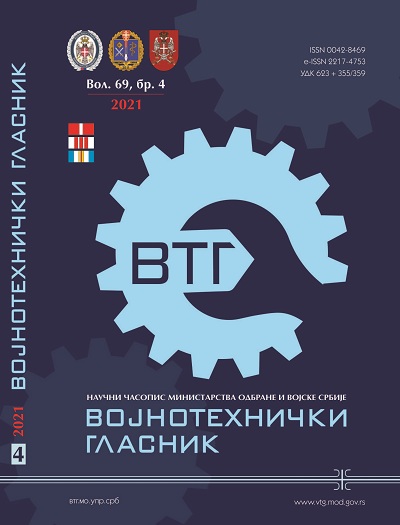Biometrijski standardi i metode
Sažetak
Uvod/cilj: U današnje vreme sistemi za identifikaciju korisnika imaju veoma važnu ulogu. Složeni zahtevi koji se odnose na sigurnost naveli su eksperte da razmatraju načine na koje bi biometrijski podaci mogli biti korišćeni za identifikaciju korisnika. U radu je predstavljen pregled biometrijskih standarda i metoda koji se mogu koristiti za identifikaciju korisnika u biometrijskim sistemima, čime bi se ostvarila zaštita informacionih i komunikacionih sistema.
Metode: Razmatraju se problemi u standardizaciji na polju biometrije. U prvom delu rada navode se konkretni primeri najčešće korišćenih biometrijskih standarda, a u drugom daje pregled biometrijskih metoda koje se najčešće upotrebljavaju.
Rezultati: Prikupljeni rezultati pokazuju da razvoj biometrijskih sistema i biometrijskih senzora doprinosi boljoj zaštiti identiteta od pogrešne upotrebe, s obzirom na to da biometrijske tehnologije imaju veliki potencijal za poboljšanje zaštite i tačnosti sistemskih operacija. Primena biometrijskih sistema povećava zaštitu korisnika, kao i omogućava bolju preciznost prilikom uspostavljanja identiteta.
Zaključak: Razvoj biometrijskih standarda treba da se fokusira na njihovu međusobnu povezanost, kao i na čvršću vezu sa ostalim IT standardima.
Reference
Al-Maadeed, S., Bourif, M., Bouridane, A. & Jiang, R. 2016. Low-quality facial biometric verification via dictionary-based random pooling. Pattern Recognition, 52, pp.238-248. Available at: https://doi.org/10.1016/j.patcog.2015.09.031.
Belcher, C. & Du, Y. 2008. A Selective Feature Information Approach for Iris Image-Quality Measure. IEEE Transactions on Information Forensics and Security, 3(3), pp.572-577. Available at: https://doi.org/10.1109/TIFS.2008.924606.
Bhardwaj, I., Londhe, N.D. & Kopparapu, S.K. 2017. A spoof resistant multibiometric system based on the physiological and behavioral characteristics of fingerprint. Pattern Recognition, 62, pp.214-224. Available at: https://doi.org/10.1016/j.patcog.2016.09.003.
Chen, Y., Atnafu, A.D., Schlattner, I., Weldtsadik, W.T., Roh, M.C., Kim, H.J., Lee, S.W., Blankertz, B. & Fazli, S. 2016. A High-Security EEG-Based Login System with RSVP Stimuli and Dry Electrodes. IEEE Transactions on Information Forensics and Security, 11(12), pp.2635-2647. Available at: https://doi.org/10.1109/TIFS.2016.2577551.
Chun, S.Y. 2016. Single pulse ECG-based small scale user authentication using guided filtering. In: International Conference on Biometrics (ICB), Halmstad, Sweden, pp.1-7, June 13-16. Available at: https://doi.org/10.1109/ICB.2016.7550065.
Jain, A., Hong, L. & Pankanti, S. 2000. Biometric identification. Communications of ACM, 43(2), pp.90-98. Available at: https://doi.org/10.1145/328236.328110.
Jain, A. K., Ross, A. & Prabhakar, S. 2004. An Introduction to Biometric Recognition. IEEE Transactions on Circuits and Systems for Video Technology, 14(1), pp.4-20. Available at: https://doi.org/10.1109/TCSVT.2003.818349.
Kumar, A. & Prathyusha, K.V. 2009. Personal Authentication Using Hand Vein Triangulation and Knuckle Shape. IEEE Transactions on Image Processing, 18(9), pp.2127-2136. Available at: https://doi.org/10.1109/TIP.2009.2023153.
Lalović, K. 2018. Patent overview: Device for fingerprint identity guarantee. Vojnotehnički glasnik/Military Technical Courier, 66(2), pp.366-379. Available at: https://doi.org/10.5937/vojtehg66-15868.
Lalović, K., Anđelić, S. & Tot, I. 2017. How to guarantee baby identity based on fingerprint biometry. In: The Ninth International Conference on Business Information Security (BISEC-2017), Belgrade, pp.1-4, October 18 [online]. Available at: http://bisec.rs/files/2017/16-k-lalovic-s-andjelic-i-tot-bisec-2017.pdf [Accessed: 20 February 2021].
Lalović, K., Maček, N., Milosavljević, M., Veinović, M., Franc, I., Lalović, J. & Tot, I. 2016a. Biometric Verification of Maternity and Identity Switch Prevention in Maternity Wards. Acta Polytechnica Hungarica, 13(5), pp.65-81. Available at: https://doi.org/10.12700/APH.13.5.2016.5.4.
Lalović, K., Milosavljević, M., Tot, I. & Maček, N. 2015. Device for Biometric Verification of Maternity. Serbian Journal of Electrical Engineering, 12(3), pp.293-302. Available at: https://doi.org/10.2298/SJEE1503293L.
Lalović, K., Nikolić, J., Tot, I. & Lalović, Ž. 2016b. Software algorithm of device for biometric identification of parenthood. In: The Eighth International Conference on Business Information Security (BISEC-2016), Belgrade, pp.66-71, October 15 [online]. Available at: https://www.metropolitan.ac.rs/files/2016/10/BISEC2016_Conference-Proceedings.pdf#page=67 [Accessed: 20 February 2021].
Lalović, K., Tot, I., Arsić, A. & Škarić, M. 2019. Security Information System, Based on Fingerprint Biometrics. Acta Polytechnica Hungarica, 16(5), pp.87-100. Available at: https://doi.org/10.12700/APH.16.5.2019.5.6.
Maček, N., Đorđević, B., Gavrilović, J. & Lalović, K. 2015. An Approach to Robust Biometric Key Generation System Design. Acta Polytechnica Hungarica, 12(8), pp.43-60. Available at: https://doi.org/10.12700/APH.12.8.2015.8.3.
Nakamura, T., Goverdovsky, V. & Mandic, D.P. 2017. In-ear EEG biometrics for feasible and readily collectable real-world person authentication. IEEE Transactions on Information Forensics and Security, 13(3), pp.648-661. Available at: https://doi.org/10.1109/TIFS.2017.2763124.
Odinaka, I., Lai, P-H., Kaplan, A.D., O’Sullivan, J.A., Sirevaag, E.J. & Rohrbaugh, J.W. 2012. ECG Biometric Recognition: A Comparative Analysis. IEEE Transactions on Information Forensics and Security, 7(6), pp.1812-1824. Available at: https://doi.org/10.1109/TIFS.2012.2215324.
Ortega-Garcia, J., Bigun, J., Reynolds, D. & Gonzalez-Rodriguez, J. 2004. Authentication gets personal with biometrics. IEEE Signal Processing Magazine, 21(2), pp.50-62. Available at: https://doi.org/10.1109/MSP.2004.1276113.
Prabhakar, S., Pankanti, S. & Jain, A.K. 2003. Biometric recognition: Security and privacy concerns. IEEE Security and Privacy, 1(2), pp.33-42. Available at: https://doi.org/10.1109/MSECP.2003.1193209.
Thevenot, D.R., Toth, K., Durst, R.A. & Wilson, G.S. 2001. Biosensors and Bioelectronics, 16(1-2), pp.121-131. Available at: https://doi.org/10.1016/S0956-5663(01)00115-4.
Tot, I., Trikoš, M., Bajčetić, J., Lalović, K. & Bogićević, D. 2021. Software Platform for Learning about Brain Wave Acquisition and Analysis. Acta Polytechnica Hungarica, 18(3), pp.147-162. Available at: https://doi.org/10.12700/APH.18.3.2021.3.8.
Unar, J.A., Seng, W.C. & Abbasi, A. 2014. A review of biometric technology along with trends and prospects. Pattern Recognition, 47(8), pp.2673-2688. Available at: https://doi.org/10.1016/j.patcog.2014.01.016.
Wang, J. & Wang, G. 2017. Quality-Specific Hand Vein Recognition System. IEEE Transactions on Information Forensics and Security, 12(11), pp.2599-2610. Available at: https://doi.org/10.1109/TIFS.2017.2713340.
Vojnotehnički glasnik omogućava otvoreni pristup i, u skladu sa preporukom CEON-a, primenjuje Creative Commons odredbe o autorskim pravima:
Autori koji objavljuju u Vojnotehničkom glasniku pristaju na sledeće uslove:
- Autori zadržavaju autorska prava i pružaju časopisu pravo prvog objavljivanja rada i licenciraju ga Creative Commons licencom koja omogućava drugima da dele rad uz uslov navođenja autorstva i izvornog objavljivanja u ovom časopisu.
- Autori mogu izraditi zasebne, ugovorne aranžmane za neekskluzivnu distribuciju rada objavljenog u časopisu (npr. postavljanje u institucionalni repozitorijum ili objavljivanje u knjizi), uz navođenje da je rad izvorno objavljen u ovom časopisu.
- Autorima je dozvoljeno i podstiču se da postave objavljeni rad onlajn (npr. u institucionalnom repozitorijumu ili na svojim internet stranicama) pre i tokom postupka prijave priloga, s obzirom da takav postupak može voditi produktivnoj razmeni ideja i ranijoj i većoj citiranosti objavljenog rada (up. Efekat otvorenog pristupa).

